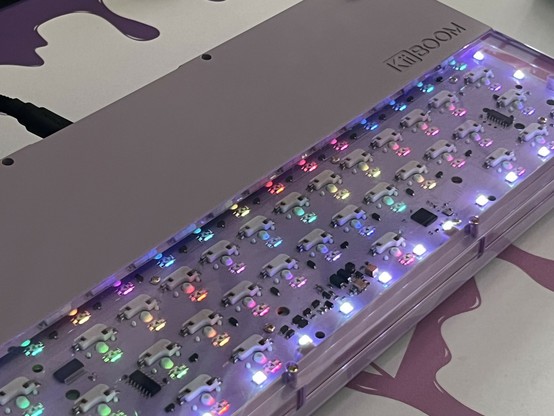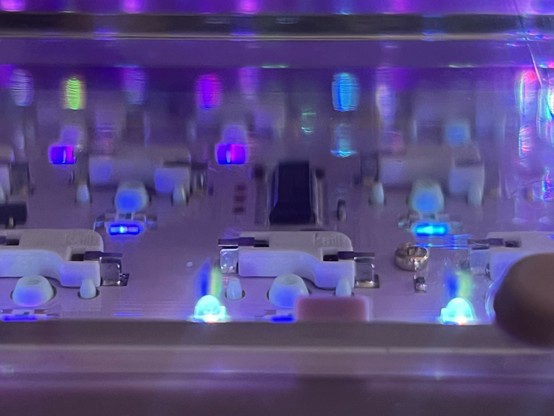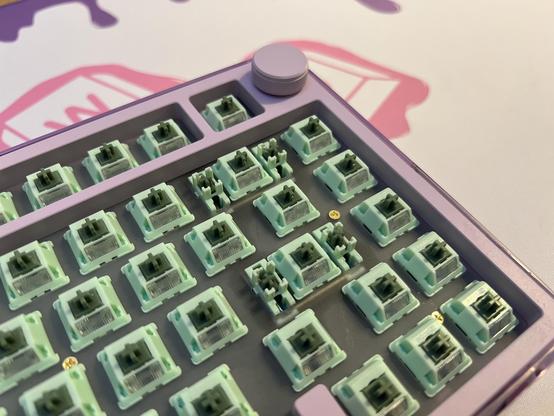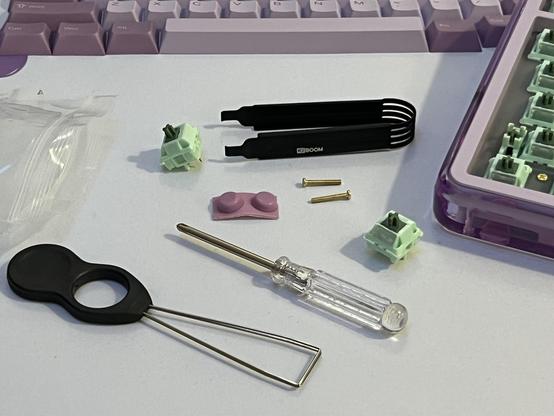KiiBOOM Breeze 75 Review
At the risk of sounding like something of a shill for KiiBOOM; I like the Breeze 75. I like it a lot.
Look, it’s not my fault they make great keyboards and put the hard graft into the fine details, okay?
Breeze 75 purple was a bold choice, but it’s growing on me a lot. One of my lucky dip desk mats from Prototypist also matches super well!
Perhaps the best way to introduce the Breeze 75 is as the less marmite version of KiiBOOM’s Phantom series. It shares a lot of design cues, but stops short of being a garishly polarising desktop spectacle in lieu of just being big and bold and practical. This is mostly accomplished by replacing the acrylic top-half with opaque plastic, and the transparent keys with… opaque keys. It’s a small but visually huge difference. The bottom of the keyboard, however, is still unashamedly KiiBOOM with a big, transparent acrylic window both showing off their PCB (sheesh I don’t even need to take this one apart either) and serving as a window for OMG ALL THE LEDs.
KiiBOOM were kind enough to send me the Purple Breeze 75, a colour that I chose by a process of elimination rather than a particularly strong preference. I was pleasantly surprised to find that it looks much, much nicer in the flesh than in their headline product photography. That does leave me wondering how the Black/White version might look, though, with its clear case and black PCB. Curses, it would have been a nice canvas for some keycap swaps!
I can’t emphasise enough how much they nail the finer details in these things.
Nonetheless the purple has been growing on me, and I particularly appreciate a cohesive set of keycaps that don’t do anything weird or wrong. It uses a classic two-tone setup with light pinky purple alphas and dark mods, with Esc and F5 to F8 also picked out in the darker purple. These are complemented with matching – but inverted – two tone legends, keeping the colour palette simple but effective. A matching knurled knob (hur hur) adorns the top right corner. The result is a thoroughly cohesive design that easily tops out the Loop 65 as my favourite KiiBOOM board.
All the shiny gooey innards on display!
Like KiiBOOM’s other acrylic keyboards it’s a hefty board, and this heft makes for a great muted typing sound. The board includes KiiBOOM’s “V2” 38gf Matcha Latte switch. Despite this low-ish actuation force I found them quite heavy to type on, since I’m switching back and forth between this and a MacBook keyboard. Missed key presses are a semi-regular occurrence, but I haven’t been frustrated enough to investigate a full replacement set of switches. Fortunately it’s a hot-swappable board so it should be an easy change to make.
Colour-keyed stabs, nice!
The switches are accompanied by matching stabilisers, keyed perfectly in the same matcha and dark green. The switches also have their plastic diffusers fitted, taking the edge off the south-facing LEDs.
Software, software, soft-where?
The Breeze 75 is cut from the same cloth as Epomaker’s Tide 75, with both being affordable, complete, but very nice 75% keyboards based on – presumably – a Westberry reference design. This is a good thing, since these boards support QMK and VIA and both are slowly working toward mainline inclusion in the QMK project. That means- to cut the jargon- that the code to make them work is available to modify and compile and maintain and improve even if (or perhaps more when) the manufacturers lose interest. For most users this doesn’t make a huge difference, but it’s a nice-to-have for the long term.
That said, KiiBOOM are still on rocky ground. They’re included in QMK’s naughty list in a thread where the maintainers dig in their heels (rightfully so) against vendors who are falling afoul of QMK’s licensing and put their pull-requests (requests to merge their code into QMK itself).
Nonetheless this keyboard has remained rooted on my desk for quite some time and has been my daily driver – though I’m missing the Galaxy 80. I don’t find myself using the QMK features at all, and I don’t think I’d miss them if KiiBOOM and co made straight-forward, simple keyboards. Suffice to say KiiBOOM have the clear edge over Epomaker here for design considerations, the bold, acrylic design of the Breeze 75 might not appeal to everyone but it’s braver, cleaner, cooler and so much more expertly executed than the fairly vanilla (but elegant, don’t get me wrong!) Tide 75.
Oh go on, let’s tear it down
Despite not needing to take it apart to see most of the shiny innards, KiiBOOM – as usual – included a screwdriver, spare screws and spare feet in their complement of tools. It would be rude not to have a poke around inside!
Tfw a keeb includes all the tools you need to disassemble it and make some simple repairs/replacements!
While I started by removing all of the keycaps (or getting the kid to do it anyway) this step wasn’t necessary since the screws are all easily accessible from the bottom. The screws eschew threaded inserts in the acrylic case by screwing instead into the aluminium parts of the case. This simple but effective choice saves a little cost in the build by playing into the strengths of the materials, KiiBOOM’s designers really are on another level.
Why have one battery when you can have two! They’re actually outside the acrylic case which isn’t super obvious here.
Opening up the case reveals not one, but two 4000mAh LiPo batteries laid side-by-side and concealed by the aluminium bottom. It also reveals that the entire bottom of the case is acrylic with, once again, screws through the shell into the aluminium bottom plate. The batteries are, in fact, outside of the acrylic enclosure and connected directly to the USB/switch daughter PCB which connects to the main PCB via a generously long ribbon cable through a hole in the acrylic. Again this simple design keeps the batteries isolated from any pointy bits with clever construction while also keeping the Breeze 75 looking phenomenal.
Overall
The Breeze 75 is my favourite KiiBOOM keyboard by far, it’s quite telling that I had to clean grunge off some of the keys. Possibly also telling that I’ve taken far too long to put out this review. While I find the keys ever so slightly too firm this is a personal preference. Similarly not everyone will be drawn to the very loud, vibrant, acrylic case- I was definitely on the fence- but I think KiiBOOM are among the best in their class for pulling this off. Love it or hate it, it’s built with love.





